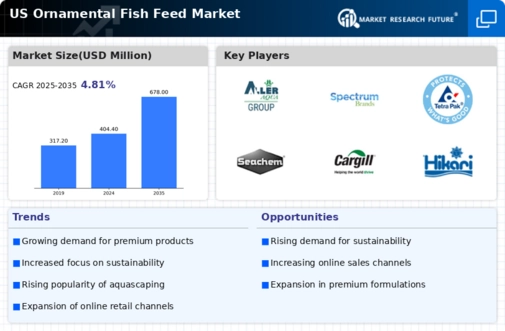The ornamental fish-feed market is characterized by a dynamic competitive landscape, driven by increasing consumer interest in aquaculture and the growing popularity of home aquariums. Key players such as Cargill (US), Tetra (DE), and Hikari (JP) are strategically positioned to leverage innovation and sustainability in their product offerings. Cargill (US) focuses on enhancing its product portfolio through research and development, aiming to provide high-quality, nutritionally balanced feeds. Tetra (DE) emphasizes digital transformation, utilizing e-commerce platforms to reach a broader customer base, while Hikari (JP) is known for its commitment to premium products, often targeting niche markets. Collectively, these strategies contribute to a competitive environment that is increasingly focused on quality, sustainability, and customer engagement.
In terms of business tactics, companies are localizing manufacturing to reduce costs and improve supply chain efficiency. The market structure appears moderately fragmented, with several players competing for market share. This fragmentation allows for diverse product offerings, yet the influence of major companies remains significant, as they set trends and standards that smaller firms often follow.
In October 2025, Cargill (US) announced a partnership with a leading aquaculture research institute to develop innovative fish-feed formulations that enhance growth rates and reduce environmental impact. This strategic move underscores Cargill's commitment to sustainability and positions the company as a leader in eco-friendly practices within the ornamental fish-feed sector. The collaboration is expected to yield products that not only meet consumer demands but also align with regulatory trends favoring sustainable aquaculture.
In September 2025, Tetra (DE) launched a new line of digital tools designed to assist aquarium enthusiasts in monitoring water quality and fish health. This initiative reflects Tetra's focus on integrating technology into its product offerings, enhancing customer experience and engagement. By providing these digital solutions, Tetra aims to differentiate itself in a competitive market, appealing to tech-savvy consumers who prioritize the health and well-being of their aquatic pets.
In August 2025, Hikari (JP) expanded its distribution network in North America by partnering with several major retailers. This strategic expansion is likely to increase Hikari's market presence and accessibility, allowing the company to reach a wider audience. The move is indicative of Hikari's strategy to capitalize on the growing demand for high-quality ornamental fish feeds, particularly among hobbyists who are willing to invest in premium products for their aquariums.
As of November 2025, current trends in the ornamental fish-feed market include a strong emphasis on digitalization, sustainability, and the integration of artificial intelligence in product development. Strategic alliances are increasingly shaping the competitive landscape, enabling companies to pool resources and expertise. Looking ahead, it appears that competitive differentiation will evolve from traditional price-based competition to a focus on innovation, technological advancements, and supply chain reliability. This shift suggests that companies that prioritize these areas will likely gain a competitive edge in the ornamental fish-feed market.

















Leave a Comment